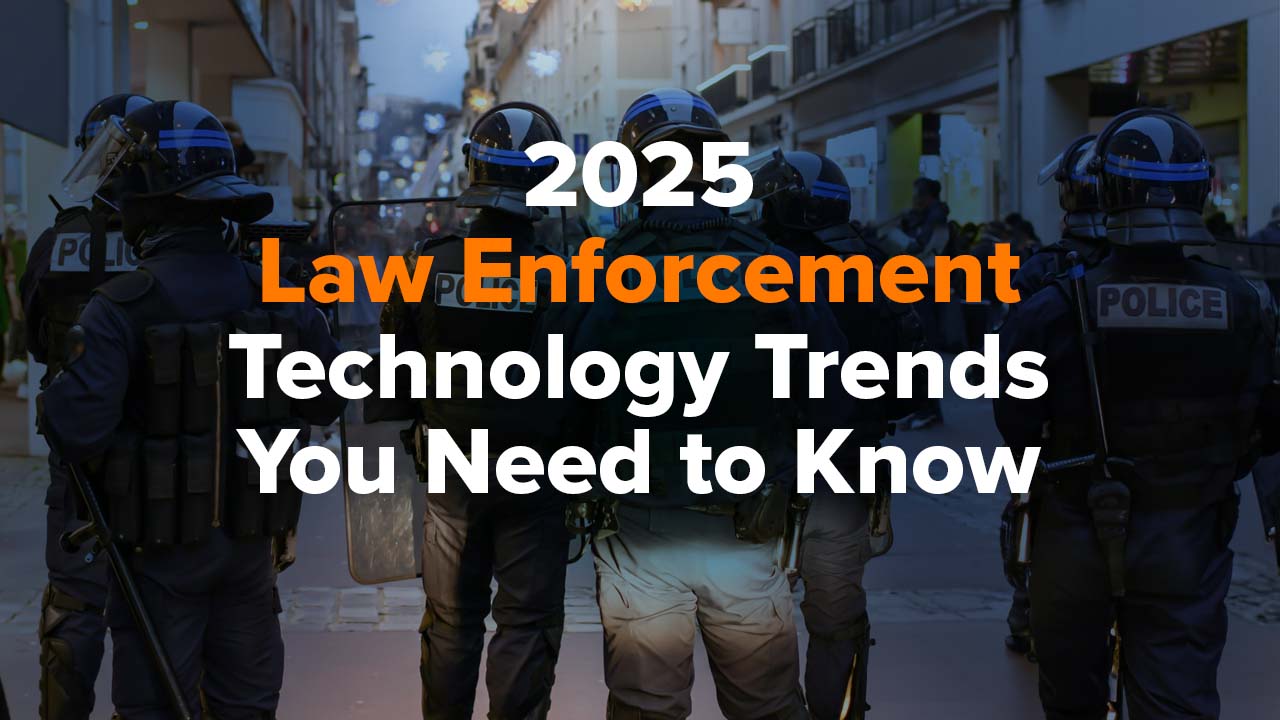By Mike French | December 13, 2024
Each year brings new challenges and opportunities for law enforcement agencies. 2025 promises to be no different, with evolving demands on Law Enforcement Agencies (LEAs) requiring innovative solutions to keep communities safe and operations efficient.
At Real Time Networks, we’ve spent the past year engaging with law enforcement professionals nationwide, identifying their priorities and challenges. We’ve identified some important patterns throughout these discussions that point toward trends we expect to see play out in the year ahead. These trends cover topics in policing, from technology adoption to addressing staffing shortages and evolving policies.
Emerging Trends in Police Technology for 2025

The Role of AI in Modern Policing
As we look ahead, we focus on leveraging smart technology—our area of expertise—to empower law enforcement personnel. Using smart technology is not just about modernizing operations but about freeing officers from time-consuming administrative burdens, enabling them to dedicate more energy to what truly matters: building safer, stronger relationships within their communities.
Modern police technology offers departments significant opportunities to enhance their capabilities, but not every solution fits every agency's unique needs. Law enforcement agencies are increasingly adopting AI-driven tools to improve public safety and operational efficiency. However, these advancements come with the critical responsibility to strictly adhere to policies governing data access and dissemination. In 2025 and beyond, the responsible use of AI enables departments to analyze vast datasets to predict and prevent crime while ensuring unbiased decision-making and maintaining high privacy and civil rights standards.
When implemented effectively, police AI technology provides officers with critical insights to address crime proactively. Thanks to AI-enhanced software, modern surveillance devices are more adept at identifying criminal activity in real time, delivering actionable intelligence that enhances officer safety and decision-making. Furthermore, these solutions help departments allocate their limited resources more strategically, increasing their ability to protect and serve their communities.

Empowering Officers with Mobile Technology
Advancements in mobile technology are equipping police officers with more powerful tools to access real-time information. In 2025, we can expect even deeper integration of mobile solutions into day-to-day policing.
Smartphones and tablets, paired with specialized apps, provide officers with immediate access to criminal databases, GPS tracking, and seamless communication with dispatch. These capabilities enhance situational awareness, support faster decision-making, and improve overall officer safety. Mobile technology also enables officers to engage more effectively with their communities by responding swiftly to incidents and maintaining a proactive, visible presence

Data-Driven Policing: A Necessity for 2025
In recent years, the focus on technology has shifted from hardware to software innovations, particularly the handling and application of big data sets. This evolution is reshaping industries, and law enforcement is no exception. Data is becoming a cornerstone of effective policing, driving decisions and strategies at every level.
As such, the technology trends shaping law enforcement today are all centered around data. From collection and analysis to secure management, leveraging data effectively is no longer optional—it’s essential for modern policing.

Maximizing Insights from IoT and Smart Devices in Law Enforcement
The surge of data generated by Internet of Things (IoT) devices presents a significant opportunity for law enforcement agencies—provided it’s effectively analyzed and managed. Beyond IoT devices, data from integrated smart systems, such as asset lockers and key cabinets, offers immense value for enhancing operational efficiency and security.
In 2025, the adoption of smart management systems is set to grow as agencies recognize the benefits of centralizing data collection and oversight for internal operations. Importantly, centralized data management doesn’t require centralized asset storage. Networked smart systems allow for distributed lockers across multiple facilities, each tailored to specific storage and administrative needs, ensuring flexibility while maintaining robust oversight.

Predictive Policing and Advanced Analytics
Predictive analytics is transforming law enforcement by helping agencies anticipate and address crime patterns with greater precision. By analyzing historical data, departments can identify high-risk areas, situations, or time frames so they can allocate resources strategically.
In 2025, predictive policing tools are expected to become even more advanced with the integration of machine learning algorithms. To deliver actionable insights, these tools will analyze extensive data sets, including crime reports, environmental factors, and social media activity. This shift empowers agencies to adopt a proactive approach to crime prevention, fostering safer communities and more effective resource deployment

Managing Digital Evidence with Scalable Solutions
The rising prevalence of IoT devices in everyday life is also reshaping the landscape of criminal investigations. These devices—ranging from body cameras and smartphones to private security systems and smart assistants—are becoming critical sources of digital evidence. As their use expands, law enforcement agencies face the challenge of securely collecting, managing, and storing this growing influx of digital data.
In 2025 and beyond, the demand for advanced digital evidence management tools will only intensify. Agencies will require robust, scalable platforms that streamline evidence intake and storage while maintaining rigorous security standards. These solutions must integrate seamlessly with physical evidence management systems, ensuring law enforcement can handle digital evidence with the same level of accountability and efficiency.
Learn More: Preserving Digital Evidence the Right Way: Your 10-Step Guide
Free eBook:
Enhance Your Agency's Asset Management
Download our free eBook to uncover effective strategies for managing police gear, weapons, keys, and evidence with smart technology.

Integrating Operational Systems for Seamless Workflows
Data's transformative role in policing will only grow, pushing forward-thinking agencies to look for ways to integrate the flow of data across the platforms they depend on. Systems like records management, evidence management, access control, and asset storage must work together to streamline operations and eliminate inefficiencies.
When officers need multiple credentials to access essential systems, valuable time is wasted, and the risk of errors increases. Double entry or disconnected workflows can lead to mistakes that hinder police work and compromise investigations. Agencies aiming to stay ahead will prioritize operational systems that integrate effortlessly, simplifying processes and enabling personnel to focus on what matters most—serving and protecting their communities.
Trends in Law Enforcement Policy
The Role of Body-Worn Cameras in Accountability
Body-worn cameras (BWCs) have become essential for law enforcement, enhancing transparency and accountability. In 2025, advancements in BWC technology are expected to improve data management, system integration, and accessibility.
Yet again, AI will revolutionize how agencies handle stored footage, enabling automated tagging, indexing, and categorization. This will simplify video retrieval, saving time and increasing efficiency during investigations.
Enhanced analytics capabilities in BWCs will allow agencies to extract actionable insights from video footage. These tools can identify trends in incidents, evaluate officer performance, and highlight areas for targeted training and development.
Streamlining Evidence Sharing with Modern Tools
Sharing CCTV footage with law enforcement has long been a slow, manual process, often requiring officers to visit sites and retrieve footage directly. This inefficiency discourages some businesses, like retailers, from reporting incidents due to time constraints or concerns about police presence during hours of operation.
Advancements in evidence management systems for handling physical and digital evidence address these challenges. Features like automated redaction and centralized access allow businesses to quickly locate and share incident-related footage while protecting privacy. Additionally, law enforcement agencies are increasingly adopting new evidence management systems to streamline the secure exchange of evidence electronically. These improvements make collaboration faster, more efficient, and less disruptive for all parties involved.
Staffing Challenges in Modern Policing
Training the Next Generation of Law Enforcement Leaders
The retirement of many baby boomer law enforcement professionals has created a wave of vacancies across all levels of policing. Whether accelerated by the pandemic or a natural generational cycle, this transition presents a unique opportunity for younger officers to step into leadership roles.
In 2025, emerging leaders will bring fresh perspectives and innovative approaches to law enforcement. These new professionals will build on the foundation laid by previous generations while shaping priorities that reflect today’s challenges and values. Initiatives like Community-Oriented Policing will continue to evolve as these leaders redefine strategies to strengthen relationships with their communities and address modern demands.
More innovative uses for civilian personnel
The rise of predictive and data-driven policing frameworks pushes law enforcement agencies to handle ever-growing volumes of information. To meet these demands, agencies are increasingly turning to civilian analysts with expertise in data science to support these initiatives.
Simultaneously, as community engagement remains a priority, agencies may look to hire social workers and other civilian specialists. This approach allows sworn officers to focus on core law enforcement duties while civilian professionals address social or civic challenges, ensuring a more balanced and effective response to community needs.
The Future of Policing is Filled with Innovative Uses for Law Enforcement Technology
All the trends shaping law enforcement in 2025 share a common goal: strengthening the connection between law enforcement personnel and their communities. Effective policies and technologies should enhance these connections, not create obstacles that drive them apart.
When implemented thoughtfully, these advancements have the potential to significantly improve policing. However, success hinges on the commitment of law enforcement leaders and their private sector partners to adopt and apply these tools effectively.
The next generation of law enforcement leaders will need a well-rounded approach to meet future challenges. This includes hiring the right personnel—both officers and civilian staff—adopting community-focused policing models, and leveraging innovative tools and technologies. By integrating these resources strategically, law enforcement agencies can foster stronger relationships, improve public safety, and ensure a brighter future for policing.
Enhancing Operational Efficiency in Law Enforcement with Advanced Technology
Real Time Networks provides integrated solutions to help law enforcement agencies efficiently manage equipment, evidence, weapons, and fleet operations. Our systems include the AssetTracer smart lockers and KeyTracer key management systems, which offer real-time tracking and secure storage to ensure critical assets are always accounted for and accessible to authorized personnel.
These systems enhance operational efficiency by automating asset and key management processes, reducing administrative burdens. They also maintain a robust chain of custody for evidence and uphold stringent security protocols, ensuring that sensitive materials are handled appropriately.
By implementing Real Time Networks' solutions, law enforcement agencies can streamline their operations and focus more effectively on their primary mission of ensuring public safety.

Maximize Efficiency in Your Department
Explore tailored key and asset management solutions designed specifically for law enforcement agencies.
Subscribe to our blog
Mike French
CEO at Real Time Networks




